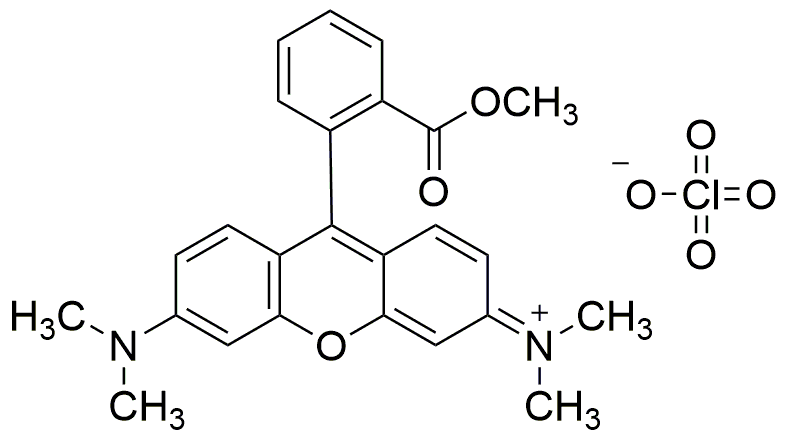Tetramethylrhodamine methyl ester perchlorate is widely utilized in research focused on:
- Fluorescent Labeling: This compound is commonly used as a fluorescent dye in biological research, allowing scientists to label and visualize proteins or cells under a fluorescence microscope. Its bright fluorescence enhances the detection of target molecules in complex samples.
- Flow Cytometry: It plays a crucial role in flow cytometry applications, where it helps in the analysis of cell populations. Researchers can use it to assess cell viability, apoptosis, and other cellular functions, providing valuable insights in immunology and cancer research.
- Live-Cell Imaging: The compound is ideal for live-cell imaging due to its photostability and low toxicity. This allows researchers to monitor dynamic biological processes in real-time, which is essential for understanding cellular behavior and interactions.
- Drug Delivery Studies: In pharmaceutical research, it is used to track the distribution of drug formulations within cells or tissues. This application aids in the development of more effective drug delivery systems and enhances the understanding of pharmacokinetics.
- Environmental Monitoring: Tetramethylrhodamine methyl ester perchlorate is also applied in environmental studies to trace pollutants in water systems. Its fluorescent properties make it a useful tool for detecting and quantifying contaminants, helping to ensure water quality and safety.
General Information
Properties
Safety and Regulations
Applications
Tetramethylrhodamine methyl ester perchlorate is widely utilized in research focused on:
- Fluorescent Labeling: This compound is commonly used as a fluorescent dye in biological research, allowing scientists to label and visualize proteins or cells under a fluorescence microscope. Its bright fluorescence enhances the detection of target molecules in complex samples.
- Flow Cytometry: It plays a crucial role in flow cytometry applications, where it helps in the analysis of cell populations. Researchers can use it to assess cell viability, apoptosis, and other cellular functions, providing valuable insights in immunology and cancer research.
- Live-Cell Imaging: The compound is ideal for live-cell imaging due to its photostability and low toxicity. This allows researchers to monitor dynamic biological processes in real-time, which is essential for understanding cellular behavior and interactions.
- Drug Delivery Studies: In pharmaceutical research, it is used to track the distribution of drug formulations within cells or tissues. This application aids in the development of more effective drug delivery systems and enhances the understanding of pharmacokinetics.
- Environmental Monitoring: Tetramethylrhodamine methyl ester perchlorate is also applied in environmental studies to trace pollutants in water systems. Its fluorescent properties make it a useful tool for detecting and quantifying contaminants, helping to ensure water quality and safety.
Documents
Safety Data Sheets (SDS)
The SDS provides comprehensive safety information on handling, storage, and disposal of the product.
Product Specification (PS)
The PS provides a comprehensive breakdown of the product’s properties, including chemical composition, physical state, purity, and storage requirements. It also details acceptable quality ranges and the product's intended applications.
Certificates of Analysis (COA)
Search for Certificates of Analysis (COA) by entering the products Lot Number. Lot and Batch Numbers can be found on a product’s label following the words ‘Lot’ or ‘Batch’.
*Catalog Number
*Lot Number
Certificates Of Origin (COO)
This COO confirms the country where the product was manufactured, and also details the materials and components used in it and whether it is derived from natural, synthetic, or other specific sources. This certificate may be required for customs, trade, and regulatory compliance.
*Catalog Number
*Lot Number
Safety Data Sheets (SDS)
The SDS provides comprehensive safety information on handling, storage, and disposal of the product.
DownloadProduct Specification (PS)
The PS provides a comprehensive breakdown of the product’s properties, including chemical composition, physical state, purity, and storage requirements. It also details acceptable quality ranges and the product's intended applications.
DownloadCertificates of Analysis (COA)
Search for Certificates of Analysis (COA) by entering the products Lot Number. Lot and Batch Numbers can be found on a product’s label following the words ‘Lot’ or ‘Batch’.
*Catalog Number
*Lot Number
Certificates Of Origin (COO)
This COO confirms the country where the product was manufactured, and also details the materials and components used in it and whether it is derived from natural, synthetic, or other specific sources. This certificate may be required for customs, trade, and regulatory compliance.


